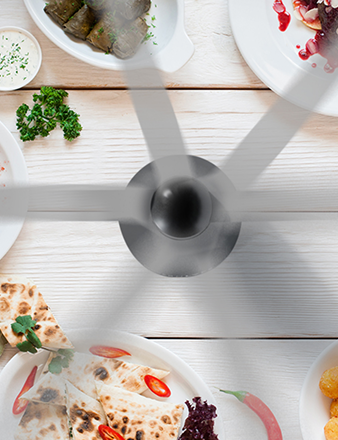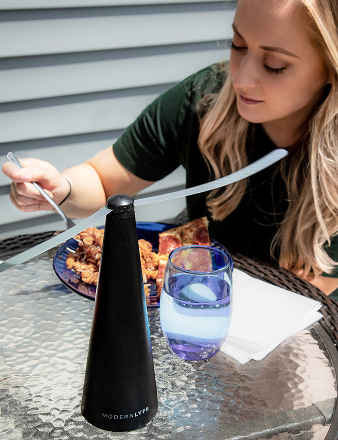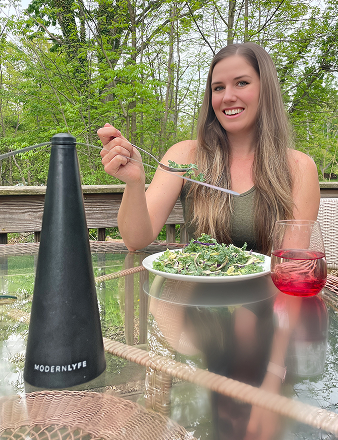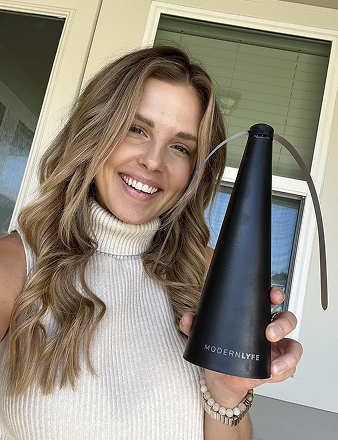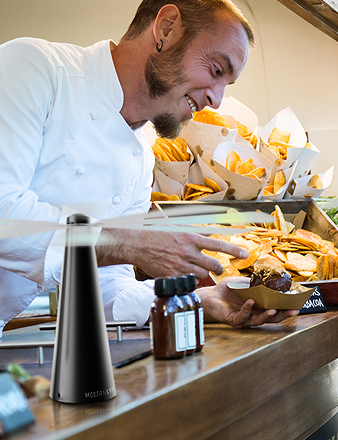Cross-contamination is the transfer of harmful germs from one place to another. It happens when bacteria or allergens move from a food, surface, or piece of equipment to another item, turning a safe meal into a health risk.
Think of it as an invisible threat. It's a primary cause of food poisoning and can happen in any kitchen, professional or home, often without anyone realizing it until it's too late.
The Invisible Threat in Your Kitchen
Imagine you're prepping dinner. You slice raw chicken on a cutting board, then use the same board and knife to chop tomatoes for a salad.
In that moment, you've likely transferred bacteria like Salmonella from the raw chicken directly to the fresh tomatoes. That's a textbook example of what is cross contamination in food. This transfer isn't limited to raw meat; germs travel on hands, utensils, and countertops, making it a widespread food safety issue.
This isn't a minor problem. Foodborne diseases affect an estimated 600 million people worldwide each year, leading to about 420,000 deaths. Cross-contamination is a major contributor to these statistics because it gives pathogens a simple way to spread.
Three Primary Pathways for Contamination
Understanding how germs move is the first step to stopping them. Cross-contamination typically occurs in one of three ways.
The Three Main Types of Cross Contamination
This table breaks down the most common ways harmful microbes spread in the kitchen.
| Type of Contamination | How It Happens | Common Example |
|---|---|---|
| Food-to-Food | Raw food touches or drips onto cooked or ready-to-eat food. | Raw chicken juices leaking onto a salad on a lower refrigerator shelf. |
| Equipment-to-Food | A contaminated utensil, cutting board, or surface touches food. | Using the same knife for raw meat and then bread without washing it. |
| People-to-Food | Bacteria are transferred from a person's hands to food. | Making hamburger patties and then preparing a fruit salad without washing your hands. |
Each scenario creates a risk for illness, but all are preventable with proper food safety habits.
For a deeper look at what cross-contamination is and how to prevent it, this guide on What Is Cross Contamination and How to Prevent It offers excellent insights.
How Germs Secretly Travel in Your Kitchen
Picture making a chicken salad. The journey for harmful bacteria begins when you place raw chicken on a cutting board. Pathogens like Salmonella or Campylobacter transfer to that surface, ready to move to their next destination.
You move the chicken to the pan, but then—without washing your hands—you grab a knife to chop lettuce. In that single action, germs travel from your hands to the knife and onto the fresh greens. This is what is cross contamination in food—a silent transfer that can lead to foodborne illness.
The contamination can continue. You might use the same unwashed cutting board to slice tomatoes. Or a fly, which can carry over 100 different pathogens, might land on raw chicken scraps before landing on your finished salad. Pests are notorious vectors for spreading germs.
Common Pathways for Contamination
These scenarios highlight the three main ways germs get around in a kitchen.
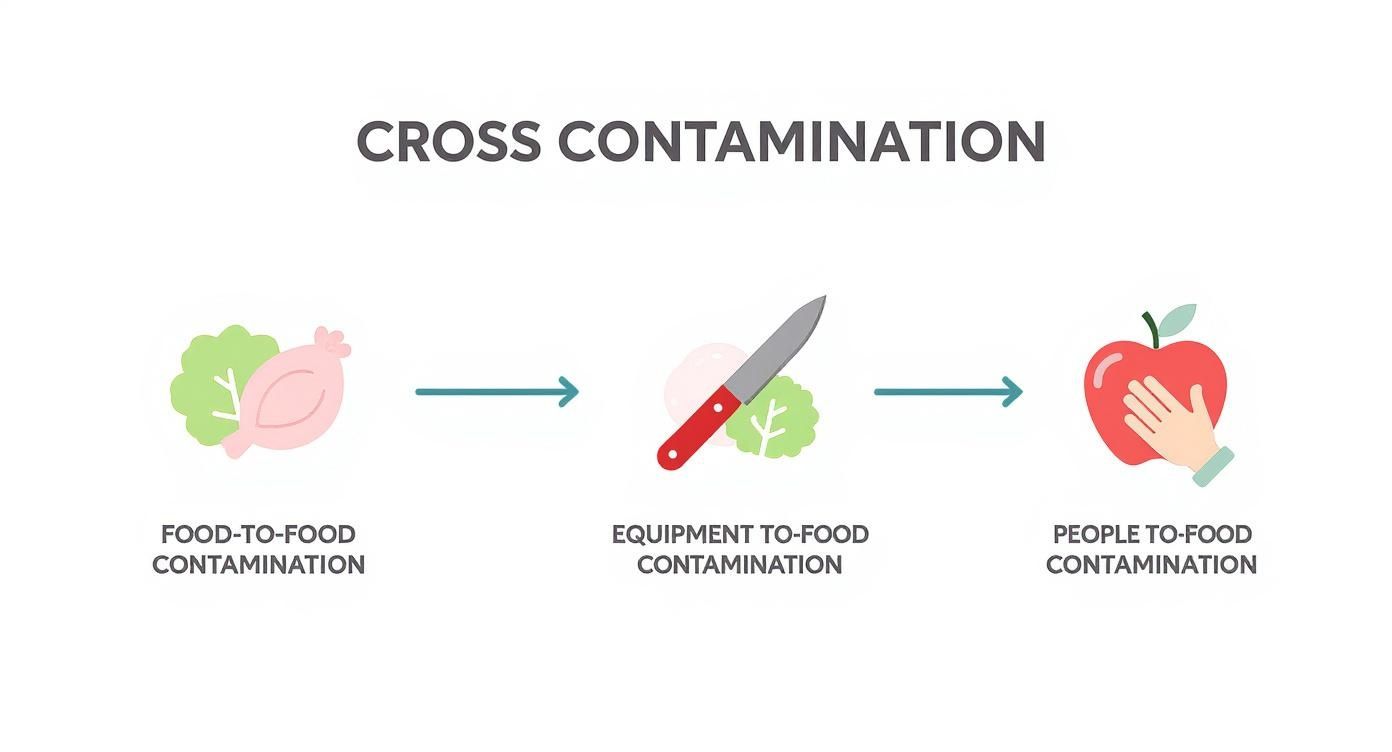
As you can see, germs can move directly between foods, from equipment to food, or be carried on our hands. It's easy to create multiple contamination points while preparing just one meal.
These oversights are more common than people think and can have serious consequences. Cross-contamination is a leading cause of foodborne outbreaks. Investigations frequently trace outbreaks back to bacteria moving from raw to cooked foods via hands or surfaces. Learn more about these food safety findings.
By understanding these hidden pathways, you can see how simple mistakes contaminate an entire meal. The key is to recognize that every surface, utensil, and hand can become a transfer point for harmful germs.
This isn't about fear; it's about empowerment. Every step in the contamination chain is an opportunity to break it. Once you know how easily germs travel, you can adopt habits that keep your food safe.
Understanding the Real Health Consequences
A simple kitchen mistake can lead to serious health issues, not just a temporary stomachache. Cross-contamination introduces dangerous bacteria like **Salmonella**, **E. coli**, and **Campylobacter** into our food and, ultimately, our bodies.These pathogens are real threats that cause severe foodborne illnesses with symptoms like intense cramping, vomiting, fever, and diarrhea. For most healthy adults, it's a few miserable days. For others, the consequences can be devastating.
The risks of cross-contamination are significantly higher for young children, older adults, pregnant women, and anyone with a compromised immune system. For these groups, a foodborne illness can lead to hospitalization or even become life-threatening.
Who Is Most at Risk?
Recognizing these risks transforms food safety from a chore into an act of care. The people we share meals with often fall into these high-risk categories, making prevention a critical responsibility.
- Young Children: Their developing immune systems are less equipped to fight off infections.
- Older Adults: A weaker immune response makes them more susceptible to severe illness from contaminated food.
- Individuals with Weakened Immunity: People with chronic conditions or those undergoing treatments like chemotherapy face a greater danger from foodborne pathogens.
The true scale of this problem is often underestimated, as many cases of foodborne illness go unreported. This issue is amplified in areas with poor sanitation or weak food safety regulations.
To fully grasp the seriousness, consider how everyday kitchen items can pose a threat. It’s worth exploring the potential health risks associated with cutting boards. Protecting the people you care about starts with knowing the dangers and learning how to prevent foodborne illness through simple, effective habits.
Your Action Plan to Prevent Cross-Contamination
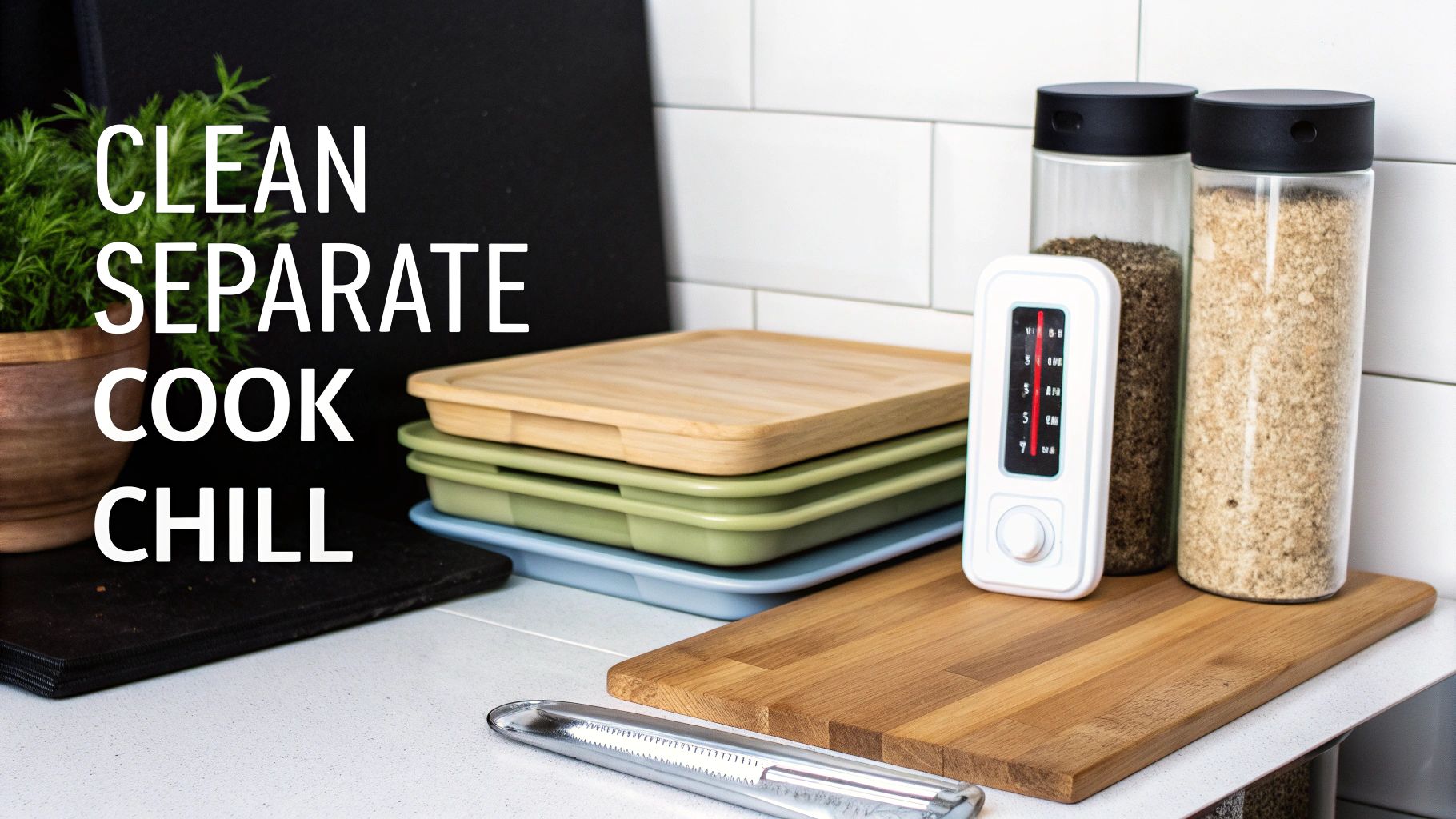
Knowing what cross-contamination is represents half the battle. Now it's time for action. Preventing the spread of harmful germs relies on simple, repeatable habits, not complex equipment.
The most effective strategy is built on four pillars of food safety: Clean, Separate, Cook, and Chill. Master these, and you'll create multiple barriers that stop bacteria. Let's break them down into practical steps.
Pillar 1: Clean Your Hands and Surfaces
This is your most critical line of defense. Your hands are the top carriers of germs in the kitchen.
Before cooking, after handling raw meat or eggs, and before touching ready-to-eat foods, wash your hands with soap and warm water for at least 20 seconds. This simple act makes a huge difference.
Equally important is keeping surfaces clean. After prepping raw meat, poultry, or seafood, wash cutting boards, dishes, and countertops with hot, soapy water. For extra safety, follow up with a food-safe sanitizer.
Pillar 2: Separate Raw From Ready-to-Eat
This rule is non-negotiable. Raw food and its juices must never contact anything that won't be cooked again.
A great method is using color-coded cutting boards: one for raw meats and another for fresh produce. If you only have one board, wash and sanitize it (and your knife) thoroughly after it touches raw meat and before you use it for anything else.
In the refrigerator, always store raw meat, poultry, and seafood in sealed containers on the bottom shelf to prevent drips from contaminating other foods.
Pillar 3: Cook to Safe Temperatures
You can't tell if food is safely cooked just by looking at it. The only way to kill harmful bacteria is to cook food to the correct internal temperature.
A food thermometer is an essential tool for every kitchen, not just for chefs. It's the only way to guarantee that meat, poultry, and egg dishes are hot enough to destroy dangerous bacteria like Salmonella and E. coli.
Memorize these key temperatures:
- Poultry (chicken, turkey): 165°F (74°C)
- Ground Meats (beef, pork): 160°F (71°C)
- Fish and Seafood: 145°F (63°C)
- Leftovers and Casseroles: 165°F (74°C)
Pillar 4: Chill Promptly
Chilling food quickly is your best defense against bacterial growth. The "danger zone" where bacteria multiply is between 40°F and 140°F. Never leave perishable foods at room temperature for more than two hours.
Set your refrigerator to 40°F (4°C) or below. When storing leftovers, divide large portions into smaller, shallow containers so they cool down faster, moving them out of the danger zone more quickly.
Your Food Safety Checklist
Here’s a quick-reference checklist summarizing the four pillars into actionable steps.
| Safety Pillar | Key Action | Why It Matters |
|---|---|---|
| Clean | Wash hands for 20 seconds; wash and sanitize surfaces after use. | Removes invisible germs from common transfer points like hands and countertops. |
| Separate | Use separate cutting boards; store raw meat on the bottom shelf of the fridge. | Prevents raw meat juices from contaminating produce and ready-to-eat foods. |
| Cook | Use a food thermometer to check for safe internal temperatures. | The only way to be certain you’ve killed harmful bacteria like Salmonella. |
| Chill | Refrigerate leftovers within 2 hours; keep the fridge at 40°F or below. | Slows the growth of dangerous bacteria, keeping food safe for later. |
Following these guidelines will make your kitchen a much safer space. For a more comprehensive look, explore our guide on how to prevent food contamination.
Taking Your Kitchen's Safety to the Next Level
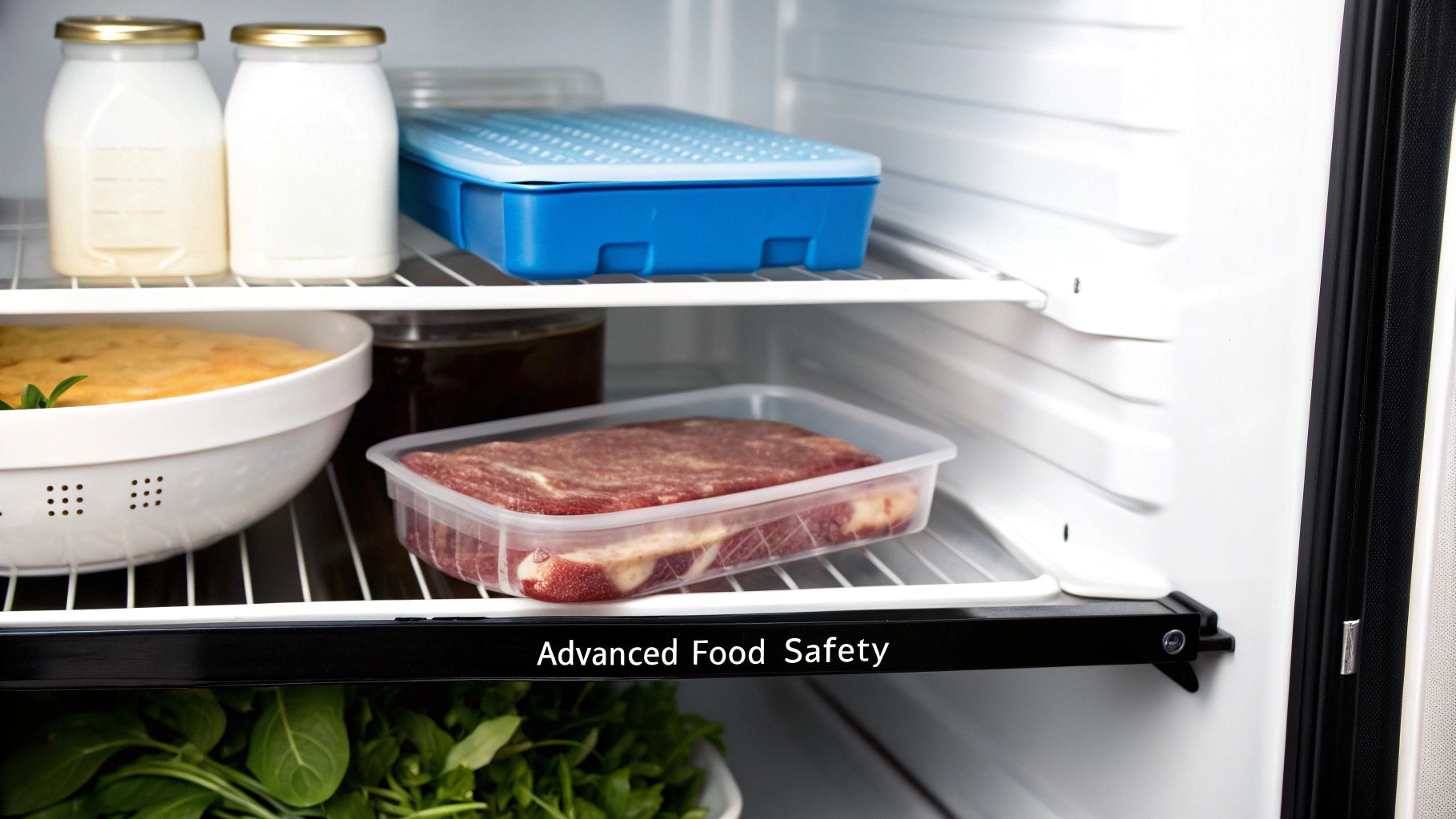
Once you've mastered the fundamentals, it's time to think bigger. True kitchen safety involves creating an environment that actively prevents germs from spreading.
A powerful habit starts at your refrigerator. Make it a rule to store raw meats, poultry, and fish in sealed containers on the bottom shelf. This simple change prevents juices from dripping onto and contaminating fresh produce or leftovers below. It’s a foundational tactic for stopping cross-contamination.
Mastering Your Kitchen Environment
Your kitchen’s environment directly impacts food safety. Flies, for instance, are more than a nuisance; a single fly can carry over 100 different disease-causing pathogens. Using tools like fly fans during meal prep creates a chemical-free barrier, keeping pests and their germs away from your food.
Another critical risk is allergen cross-contact. This is the transfer of a food protein—like peanut dust or gluten—from one food to another. For someone with a severe allergy, even a trace amount can trigger a life-threatening reaction.
The same discipline used to fight bacteria applies here. To prevent allergen cross-contact, use completely separate utensils, cutting boards, and cooking surfaces when preparing allergen-free meals. This is an essential step to protect your family and guests.
Adopting these advanced strategies sets a truly safe kitchen apart. It's about building a system to identify and control risks before they become problems. You can learn how professionals achieve this by exploring what is HACCP in food safety and applying those principles at home.
Common Questions About Cross-Contamination
Even with the basics down, practical questions about cross-contamination still arise. Getting clear answers builds confidence and helps keep your kitchen safe.
Can Cross-Contamination Happen in a Microwave?
Yes. When you heat uncovered raw meat, splatters can coat the microwave's interior. If you then heat other food without cleaning it, those germs can transfer to your ready-to-eat meal. The solution is simple: always cover food and wipe down your microwave regularly.
Does Cooking Kill Everything?
Cooking food to the correct temperature kills most dangerous bacteria. However, it's not a failsafe. Some bacteria produce heat-resistant toxins, especially if food has been left in the temperature "danger zone" for too long. This is why prevention is always the best strategy.
Cooking is your final line of defense, but it can't reverse poor food handling. The goal is to stop germs from spreading in the first place, ensuring food is safe from preparation to consumption.
Is It Safe to Reuse a Cutting Board After Handling Raw Meat?
Only after a thorough cleaning with hot, soapy water followed by a sanitizer. A much safer and simpler habit is to use two separate boards: one strictly for raw meat, poultry, and fish, and another for everything else, like fruits and vegetables. This single change drastically reduces your risk.
How Is Allergen Cross-Contamination Different?
This is a critical distinction. Microbial contamination involves fighting germs. Allergen cross-contact involves the transfer of a food protein, such as from peanuts or gluten. For someone with a severe allergy, a microscopic amount can trigger a life-threatening reaction. The principles of cleaning and separation are the same, but the stakes require extreme care.
Keep your kitchen and dining areas free from airborne pests with MODERN LYFE. Our elegant fly fans provide a chemical-free barrier to protect your food and enhance your guests' comfort. Visit us to see how our solutions can make your space safer and more enjoyable.

